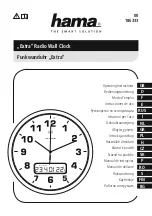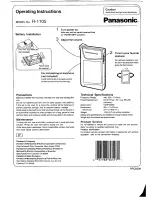
38
39
E1
MANUAL
This display is shown in the following illustration.
LOCAL / GMT TIME SELECT
1. CLOCKS
- This identifies the menu as being the CLOCK GMT / LOCAL selection menu.
2. LOCAL
- Press this softkey to cause Local time to be shown on all menus and displays.
3. GMT
- Press this softkey to cause universal (GMT) time to be shown on all menus and displays.
4. TIMER 1 2
- This indicates that either timer 1, 2, or both are enabled.
5. L / GMT
- Indicates that the time displayed is either Local (L) or universal (GMT) time.
E1 MENUS continued
SEEK FUNCTION
DESCRIPTION
The
etón
E1 incorporates a SEEK function which
allows the user to search for signals in VFO, MEMORY
or COUNTRY mode which have signal strengths that
exceed a predetermined level which the user deter-
mines by the setting of the SQUELCH knob.
VFO MODE
To use SEEK in VFO mode, proceed as follows:
(1) Select the frequency range you would like to scan.
This can be FM, MW, LW, or SW.
(2) Set the SQUELCH control so that the Squelch Level
Indicator (located below the signal strength
indicator) is set at the desired level.
(3) Press the ‘SEEK’ key. The receiver will scan through
the selected band in 5 kHz steps on LW band, 9 or
10 kHz steps on MW band, 5 kHz steps on SW
band, and 200 kHz steps on FM band. Signals that
are strong enough to cause the signal strength
indicator display bars to extend further to the right
than the Squelch Level indicator will cause SEEK to
stop on that signal, and the signal will be heard.
(4) The receiver will remain on that signal until the
‘SEEK’ key is pressed again.
(5) If the receiver continues to SEEK but cannot find a
signal, you may press ‘SEEK’ again to stop the
SEEK.
MEMORY & COUNTRY MODE
To use SEEK in MEMORY and COUNTRY modes, select-
ed frequencies must be programmed into several of
the MEMORY and/or COUNTRY channels. Programming
of MEMORY channels is covered on page 26 and pro-
gramming of COUNTRY channels is covered on page
28. Once MEMORY and/or COUNTRY channels are pro-
grammed as desired, proceed as follows:
(1) Press the ‘MEMORY’ or ‘COUNTRY’ softkey to enter
the desired mode.
(2) Set the ‘SQUELCH’ knob to the desired level. (HINT:
Set the ‘SQUELCH’ control high enough (clockwise)
E1 MENUS continued
TIMER 2 ENABLE / DISABLE
This menu is used to enable and disable event timer number 2. It is reached by pressing the ‘TIME’ key a second
time. The ON time, OFF time, and MEMORY or COUNTRY channel shown on this menu must be entered using the
TIMERS menu. The TIMER 2 ENABLE / DISABLE display appears as shown in the following illustration.
1. TIMER 2
- This display entry identifies this menu as being associated with Timer 2.
2. START TIME
- This shows the time that Timer 2 is set up to turn on when enabled.
3. STOP TIME
- This shows the time that Timer 2 is set to turn off when enabled.
4. Memory or Country channel selected
- This menu entry identifies the MEMORY or COUNTRY channel
which was programmed into Timer 2. This is the frequency that will be received when timer 2 on time is reached.
5. DISABLE
- Press the ‘DISABLE softkey to disable Timer 2.
6. ENABLE
- Press the ‘ENABLE’ softkey to activate Timer 2.
7. TIMER 2
- This display entry will appear when Timer 2 has been enabled. It will be present on all menus and dis-
plays as long as Timer 2 is active. If both Timer 1 and 2 are active, it will read “TIMER 1 2". If neither timer is active,
it will not be visible on any menu.
LOCAL / GMT TIME SELECT
This menu is used to select whether the clock displayed on all other displays shows time in GMT or Local time. It is
reached by pressing the ‘TIME’ key a third time. Pressing the ‘TIME’ key a fourth time takes the user back to the VFO,
MEMORY or COUNTRY display, whichever was in use when ‘TIME’ was pressed initially.
LOCAL / GMT TIME SELECT
This menu is used to select whether the clock displayed on all other displays shows time in GMT or Local time. It is
reached by pressing the ‘TIME’ key a third time. Pressing the ‘TIME’ key a fourth time takes the user back to the VFO,
MEMORY or COUNTRY display, whichever was in use when ‘TIME’ was pressed initially.















































